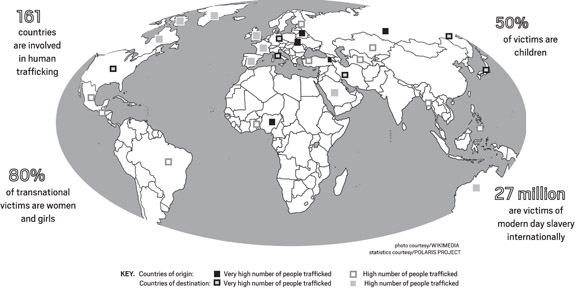 By CATHERINE PORTER
By CATHERINE PORTER
Lingering around the world are the vestiges of a trade that dates back to ancient times. Although it was outlawed nearly 140 years ago, slavery has yet to be conquered.
Long ago, African Americans toiled on southern farms under harsh conditions. Over the course of almost four centuries, an estimated 12 million slaves were brought to the United States.
In comparison to the antebellum slave trade, there are currently 27 million people enslaved globally. Stretching around the world, human trafficking exists on every habitable continent. Most often, victims are kidnapped or otherwise taken as slaves and forced to work for those who exploit them.
One of the most recent occurrences of human trafficking stems from the disaster in Haiti. In the face of national turmoil, its citizens are susceptible to human trafficking. Often lured under false pretenses, families or individuals find themselves roped by the bonds of slavery.
“The only solution I see would be to impose higher penalties on users such as employers who use bond servants like those from Haiti. If you make it unprofitable, then [human trafficking] will stop,” American History teacher Michael Dorman said.
In the U.S. alone, the Department of Justice estimates that 14,500 to 17,500 people are trafficked to the country annually.
As depicted in the recent film, Taken, a large portion of the global human trafficking trade exists to fuel the sex trade. The U.S. Department of State reports that 80 percent of victims are female, with 70 percent being forced into the commercial sex trade.
“Sexual trafficking is probably the worst form of human trafficking because it’s so dehumanizing; it’s ruining [the victims’] lives because they will always be carrying [their experiences] with them,” junior Talissa Soto said.
If not being used for sexual exploitation, those trafficked are often victims of forced labor. Victims may work in
factories, agricultural fields or even businesses such as restaurants. Anywhere from $13,000 to $67,200 can be generated by each victim annually.
“Human trafficking basically violates every precept of the U.S. Constitution. If you indulge in it, then you’re saying that you’ve sold your principles for economic gain,” Dorman said.
To combat the ever-growing slave trade, organizations such as the Polaris Project, Not For Sale and Amnesty International have gotten involved. Together, these groups wish to promote a global awareness of human trafficking and work to effectively end the demeaning trade.
“I think it’s important that the American public be aware of the scope of the issue. Nobody talks about the issue, and you can’t fix anything if you don’t know you have a problem,” Magnet Law teacher Cindy Schmidt said.
As awareness of human trafficking grows, so does information on the actual trade. The Web site Change.org originally started in 2005 when founder Ben Rattray wished to address the need for people to affect change within their communities. Many of its members are students, and the site gives 10 ways for students to combat human trafficking. Ideas range from hosting viewing parties to buying fair trade, which supports companies that ensure fair wages and conditions. Such products can range from clothing to coffee and can be bought on Web sites such as Globalexchangestore.org.
“The best way for students to get involved is to promote awareness; most of the time, it’s about being informed on
issues and saying ‘This needs to be addressed,’” sophomore Kinsey Seacord said. “[The main problem with student involvement] is persecution; it’s hard to face other students and stand up for what you believe in. Some may think it’s dorky or nerdy, but you have to do what’s right.”
As the nation and private organizations pool efforts to combat human trafficking, the world awaits the end of a demeaning trade. Though as ancient as the first civilizations, the combination of greater awareness and implementation of harsher penalties may forever end the exploitation of human beings.